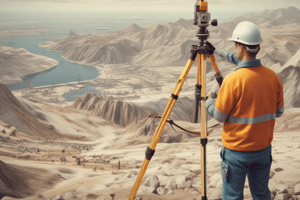Podcast
Questions and Answers
What is the first step in measuring horizontal distances using the pace factor?
What is the first step in measuring horizontal distances using the pace factor?
- Use an optical rangefinder
- Set up a 100-meter segment (correct)
- Calculate your average pace
- Measure a segment of 50 meters
Which of the following is NOT a method used for measuring horizontal distances?
Which of the following is NOT a method used for measuring horizontal distances?
- Thermal imaging (correct)
- Taping
- Pacing
- Electronic Distance Measurement
Which tool is commonly used in the process of measuring horizontal distances?
Which tool is commonly used in the process of measuring horizontal distances?
- Compass
- Barometer
- Protractor
- Calculator (correct)
What method uses a set distance to determine pace in measuring?
What method uses a set distance to determine pace in measuring?
What type of measurements does tacheometry (stadia) provide?
What type of measurements does tacheometry (stadia) provide?
Which of these instruments is specifically used for precise distance measurements?
Which of these instruments is specifically used for precise distance measurements?
In what context is an odometer typically used when measuring distances?
In what context is an odometer typically used when measuring distances?
Which method would NOT be appropriate for measuring horizontal distances in engineering surveying?
Which method would NOT be appropriate for measuring horizontal distances in engineering surveying?
What is the primary factor affecting the measured length of a tape when it is unsupported in the middle?
What is the primary factor affecting the measured length of a tape when it is unsupported in the middle?
At what temperature was the 30-meter steel tape standardized?
At what temperature was the 30-meter steel tape standardized?
How does the tension on the tape affect the measured length?
How does the tension on the tape affect the measured length?
What correction due to environmental factors is necessary when measuring horizontal distances?
What correction due to environmental factors is necessary when measuring horizontal distances?
The weight of the tape per unit length is crucial for calculating which correction?
The weight of the tape per unit length is crucial for calculating which correction?
Which parameter is least likely to directly influence the measurement of horizontal distances on its own?
Which parameter is least likely to directly influence the measurement of horizontal distances on its own?
What is the effect of a correction for incorrect length of a tape?
What is the effect of a correction for incorrect length of a tape?
What role does the forward person play in measuring horizontal distances with a tape?
What role does the forward person play in measuring horizontal distances with a tape?
In what scenario would you need to apply a correction to the tape length?
In what scenario would you need to apply a correction to the tape length?
Which of the following factors does NOT require a correction when measuring tape length?
Which of the following factors does NOT require a correction when measuring tape length?
What is the standard pull applied to a tape during measurements?
What is the standard pull applied to a tape during measurements?
Why is it necessary to use a standardized length for steel tapes?
Why is it necessary to use a standardized length for steel tapes?
How do you mark the end of the measured line between the persons involved in measurement?
How do you mark the end of the measured line between the persons involved in measurement?
What is the formula for correction due to temperature change in tape measurement?
What is the formula for correction due to temperature change in tape measurement?
What modulus of elasticity is assigned to the tape used in measuring horizontal distances?
What modulus of elasticity is assigned to the tape used in measuring horizontal distances?
What is the purpose of using a leveling rod in surveying?
What is the purpose of using a leveling rod in surveying?
What was the tension applied to the steel tape when measuring the line from A to B?
What was the tension applied to the steel tape when measuring the line from A to B?
Which tool is used primarily to measure and layout points and elevations on the ground?
Which tool is used primarily to measure and layout points and elevations on the ground?
What is the standardized length of the 30-meter steel tape when it is at 20°C?
What is the standardized length of the 30-meter steel tape when it is at 20°C?
What is one of the main uses of a tripod in surveying?
What is one of the main uses of a tripod in surveying?
What should be done to obtain the corrected distance when measuring with a tape?
What should be done to obtain the corrected distance when measuring with a tape?
What is the weight per meter of the steel tape mentioned in the content?
What is the weight per meter of the steel tape mentioned in the content?
How is the pace factor used in measuring distances?
How is the pace factor used in measuring distances?
What does 'D' represent in the context of measuring horizontal distances?
What does 'D' represent in the context of measuring horizontal distances?
What is the commonly accepted value for the stadia interval factor in tacheometry?
What is the commonly accepted value for the stadia interval factor in tacheometry?
What does the instrument constant represent in the measurement process?
What does the instrument constant represent in the measurement process?
Which method is NOT mentioned as a way to measure horizontal distances?
Which method is NOT mentioned as a way to measure horizontal distances?
In tacheometry, what geometric concept is essential for calculating horizontal distances?
In tacheometry, what geometric concept is essential for calculating horizontal distances?
Flashcards
Pace Factor
Pace Factor
A calculated ratio used to convert the number of paces taken to a horizontal distance.
Pacing
Pacing
Measuring horizontal distance by counting steps/paces.
Odometer Readings
Odometer Readings
Measuring distance using a device that records wheel rotations.
Optical Rangefinders
Optical Rangefinders
Signup and view all the flashcards
Tacheometry
Tacheometry
Signup and view all the flashcards
Taping
Taping
Signup and view all the flashcards
Electronic Distance Measurement (EDM)
Electronic Distance Measurement (EDM)
Signup and view all the flashcards
Satellite Measurement
Satellite Measurement
Signup and view all the flashcards
Measuring Horizontal Distances
Measuring Horizontal Distances
Signup and view all the flashcards
Tape Length Correction (Temperature)
Tape Length Correction (Temperature)
Signup and view all the flashcards
Tape Length Correction (Pull)
Tape Length Correction (Pull)
Signup and view all the flashcards
Measuring Tape Standard Temperature
Measuring Tape Standard Temperature
Signup and view all the flashcards
Incorrect Tape Length
Incorrect Tape Length
Signup and view all the flashcards
Range Poles
Range Poles
Signup and view all the flashcards
Tape Procedure
Tape Procedure
Signup and view all the flashcards
Steel tape standardization
Steel tape standardization
Signup and view all the flashcards
Horizontal distance measurement
Horizontal distance measurement
Signup and view all the flashcards
Tape tension
Tape tension
Signup and view all the flashcards
Corrected distance
Corrected distance
Signup and view all the flashcards
Levelling Rod
Levelling Rod
Signup and view all the flashcards
Theodolite/Transit
Theodolite/Transit
Signup and view all the flashcards
Tripod
Tripod
Signup and view all the flashcards
Tape standardization temperature
Tape standardization temperature
Signup and view all the flashcards
Tape standardization tension
Tape standardization tension
Signup and view all the flashcards
Tape sag correction
Tape sag correction
Signup and view all the flashcards
Measuring tape weight
Measuring tape weight
Signup and view all the flashcards
Measuring tape tension
Measuring tape tension
Signup and view all the flashcards
Correction due to temperature change
Correction due to temperature change
Signup and view all the flashcards
Horizontal Distance in Tacheometry
Horizontal Distance in Tacheometry
Signup and view all the flashcards
Stadia Interval Factor
Stadia Interval Factor
Signup and view all the flashcards
Instrument Constant
Instrument Constant
Signup and view all the flashcards
Formula for Horizontal Distance
Formula for Horizontal Distance
Signup and view all the flashcards
What is Tacheometry?
What is Tacheometry?
Signup and view all the flashcards
Study Notes
Measurement of Horizontal Distance
- The lecture covers methods for measuring horizontal distances
- Outcomes include measuring distance using pace factors, measuring tapes, and surveying instruments
- Discussion will cover concepts, theories, and information for objectives 1-2
- Participants will share insights and apply the taught concepts through problem-solving
- Evaluation session including open forum with student evaluation for feedback and lecturer evaluation
- Tools listed for measuring horizontal distance include calculators, notes and pen, and references
Methods in Measuring Length
- Pacing: Measuring distance by counting steps
- Odometer Readings: Using a device to track distance traveled
- Optical Rangefinders: Instruments that measure distance optically
- Tacheometry (Stadia): A method using angled measurements to determine distance
- Taping: Measuring using a tape measure
- Electronic Distance Measurement: Using electronic devices to measure distance
- Satellite: Utilizing satellite technology for distance measurements
Obtaining Pace Factor
- Procedure for determining pace factor involves:
- Setting up a known 100-meter segment
- Pacing the segment from heel to heel
- Counting the number of paces taken
- The pace factor is calculated by dividing the measured distance by the number of paces
Measurement Using Tape
- Marks both ends of the line with range poles
- The person with the zero mark of the tape leads the process while the second person holds the tape itself
- The forward person marks the point and calls “stick” when the tape is aligned
- The rear person marks the other end with "stuck"
- Corrections for incorrect tape length require considering factors of the tape's actual length, standard length, and recorded length of the line, temperature variations and consistent pull.
- Correction formulas for the aforementioned cases are also discussed
Incorrect Length of Tape
- Steel tapes are calibrated at 20°C
- Correction for temperature change is needed based on the difference between the standardized and measured temperatures
- Correction for inconsistent pull also needs to be considered with variables like standard pull on tape, observed pull on tape, cross-sectional area of tape, and the modulus of elasticity of tape.
- Corrections for sag involving unsupported length of tape, weight of tape per unit length, and amount of pull on tape.
- Examples for applying the correction formulas involve distance measurements, temperature, and other variables
Learning Exercises (Example)
- A 30-meter steel tape is standardized at 20°C
- The tape's measurements need corrections for temperature, inconsistent pull, and sag.
- Data like measured distances (section), temperature, and recorded distances are provided.
- Students need to calculate the correct distance after applying the corrections
Surveying Tools and Equipment
- Leveling Rod: Used for measuring elevation and establishing points for ground measurements
- Theodolite/Transit: Electronic/manual device with a telescope and compass used to measure and layout points and elevations on the ground
- Tripod: For mounting theodolite, transit, or total station
- Measuring Distance using Tacheometry: Measuring distance by trigonometry, using the stadia interval factor and instrument constant.
Learning Assessments
- Fieldwork no. 1: Measuring Distance Using Pace Factor
- Fieldwork no. 2: Measuring Distance by Tacheometry
- Cross-Section Properties: Locate the centroid of a cross-section
Studying That Suits You
Use AI to generate personalized quizzes and flashcards to suit your learning preferences.




